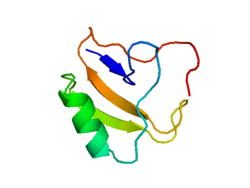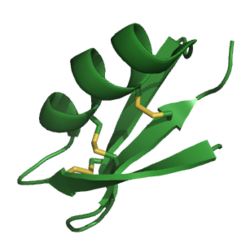Biology:Scorpion toxin
| Scorpion long-chain toxin | |||||||||
|---|---|---|---|---|---|---|---|---|---|
 Crystal structure of toxin II from the scorpion Androctonus australis Hector.[1] | |||||||||
| Identifiers | |||||||||
| Symbol | Toxin_3 | ||||||||
| Pfam | PF00537 | ||||||||
| InterPro | IPR002061 | ||||||||
| SCOP2 | 2sn3 / SCOPe / SUPFAM | ||||||||
| TCDB | 8.B.1 | ||||||||
| OPM superfamily | 58 | ||||||||
| OPM protein | 1djt | ||||||||
| |||||||||
| Scorpion short toxin | |||||||||
|---|---|---|---|---|---|---|---|---|---|
 | |||||||||
| Identifiers | |||||||||
| Symbol | Toxin_2 | ||||||||
| Pfam | PF00451 | ||||||||
| Pfam clan | CL0054 | ||||||||
| InterPro | IPR001947 | ||||||||
| PROSITE | PDOC00875 | ||||||||
| TCDB | 8.B.2 | ||||||||
| OPM superfamily | 58 | ||||||||
| OPM protein | 1ne5 | ||||||||
| |||||||||
Scorpion toxins are proteins found in the venom of scorpions. Their toxic effect may be mammal- or insect-specific and acts by binding with varying degrees of specificity to members of the Voltage-gated ion channel superfamily; specifically, voltage-gated sodium channels, voltage-gated potassium channels,[3] and Transient Receptor Potential (TRP) channels.[4][5] The result of this action is to activate or inhibit the action of these channels in the nervous and cardiac organ systems. For instance, α-scorpion toxins MeuNaTxα-12 and MeuNaTxα-13 from Mesobuthus eupeus are neurotoxins that target voltage-gated Na+ channels (Navs), inhibiting fast inactivation. In vivo assays of MeuNaTxα-12 and MeuNaTxα-13 effects on mammalian and insect Navs show differential potency. These recombinants (MeuNaTxα-12 and MeuNaTxα-13) exhibit their preferential affinity for mammalian and insect Na+ channels at the α-like toxins' active site, site 3, in order to inactivate the cell membrane depolarization faster[6]. The varying sensitivity of different Navs to MeuNaTxα-12 and MeuNaTxα-13 may be dependent on the substitution of a conserved Valine residue for a Phenylalanine residue at position 1630 of the LD4:S3-S4 subunit or due to various changes in residues in the LD4:S5-S6 subunit of the Navs.[6] Ultimately, these actions can serve the purpose of warding off predators by causing pain (e.g., through the activation of sodium channels or TRP channels in sensory neurons)[7] or to subdue predators (e.g., in the case of inhibition of cardiac ion channels).[8]
The family includes related short- and long-chain scorpion toxins. It also contains a group of proteinase inhibitors from the plants Arabidopsis thaliana and Brassica spp.
The Brassica napus (oil seed rape) and Sinapis alba (white mustard) inhibitors,[9][10] inhibit the catalytic activity of bovine beta-trypsin and bovine alpha-chymotrypsin, which belong to MEROPS peptidase family S1 (InterPro: IPR001254).[11]
This group of proteins is now used in the creation of insecticides, vaccines, and protein engineering scaffolds.
Structure
The complete covalent structure of several such toxins has been deduced: They comprise around 66 amino acid residues forming a three stranded anti-parallel beta sheet over which lies an alpha helix of approximately three turns. Four disulfide bridges cross-link the structure of the long-chain toxins whereas the short toxins contain only three.[12][13] BmKAEP, an anti-epilepsy peptide isolated from the venom of the Manchurian scorpion,[14] shows similarity to both scorpion neurotoxins and anti-insect toxins.
Function
The toxin's molecular function is to inhibit ion channels. The two types of Na+ channel toxins can be divided into two groups (alpha and beta) based on their functional effects. Beta (β) toxins shift the voltage-dependence of activation to more negative potentials, making the channel more likely to open at membrane potentials where activation would normally not occur. Alpha (α) toxins inhibit the fast inactivation mechanism, prolonging Na+ current through the channel.[15] The toxins are used in insecticides, vaccines, and protein engineering scaffolds[citation needed]. The toxins are now used to treat cancer patients by injecting fluorescent scorpion toxin into cancerous tissue to show tumor boundaries[citation needed]. Scorpion toxin genes are also used to kill insect pests by creating hypervirulent fungus in the insect through gene insertion[citation needed].
Subfamilies
References
- ↑ PDB: 1PTX; "Crystal structure of toxin II from the scorpion Androctonus australis Hector refined at 1.3 A resolution". Journal of Molecular Biology 238 (1): 88–103. April 1994. doi:10.1006/jmbi.1994.1270. PMID 8145259.
- ↑ "Solution structure of the potassium channel inhibitor agitoxin 2: caliper for probing channel geometry". Protein Science 4 (8): 1478–89. August 1995. doi:10.1002/pro.5560040805. PMID 8520473.
- ↑ "The charybdotoxin family of K+ channel-blocking peptides". Neuron 15 (1): 5–10. July 1995. doi:10.1016/0896-6273(95)90057-8. PMID 7542463.
- ↑ "Selective spider toxins reveal a role for the Nav1.1 channel in mechanical pain". Nature 534 (7608): 494–9. June 2016. doi:10.1038/nature17976. PMID 27281198. Bibcode: 2016Natur.534..494O.
- ↑ "A Cell-Penetrating Scorpion Toxin Enables Mode-Specific Modulation of TRPA1 and Pain". Cell 178 (6): 1362–1374.e16. September 2019. doi:10.1016/j.cell.2019.07.014. PMID 31447178.
- ↑ "Two recombinant α-like scorpion toxins from Mesobuthus eupeus with differential affinity toward insect and mammalian Na(+) channels". Biochimie 95 (9): 1732–40. September 2013. doi:10.1016/j.biochi.2013.05.009. PMID 23743216.
- ↑ "Receptor-targeting mechanisms of pain-causing toxins: How ow?". Toxicon 60 (3): 254–64. September 2012. doi:10.1016/j.toxicon.2012.04.336. PMID 22538196.
- ↑ "From foe to friend: using animal toxins to investigate ion channel function". Journal of Molecular Biology 427 (1): 158–175. January 2015. doi:10.1016/j.jmb.2014.07.027. PMID 25088688.
- ↑ "Purification, inhibitory properties, amino acid sequence and identification of the reactive site of a new serine proteinase inhibitor from oil-rape (Brassica napus) seed". FEBS Letters 342 (2): 221–4. April 1994. doi:10.1016/0014-5793(94)80505-9. PMID 8143882.
- ↑ "Purification, inhibitory properties and amino acid sequence of a new serine proteinase inhibitor from white mustard (Sinapis alba L.) seed". FEBS Letters 301 (1): 10–4. April 1992. doi:10.1016/0014-5793(92)80199-Q. PMID 1451776.
- ↑ "Evolutionary families of peptidase inhibitors". The Biochemical Journal 378 (Pt 3): 705–16. March 2004. doi:10.1042/BJ20031825. PMID 14705960.
- ↑ "Primary structure of scorpion anti-insect toxins isolated from the venom of Leiurus quinquestriatus quinquestriatus". FEBS Letters 261 (2): 423–6. February 1990. doi:10.1016/0014-5793(90)80607-K. PMID 2311768.
- ↑ "Covalent structure of toxins I and II from the scorpion Buthus occitanus tunetanus". Toxicon 21 (1): 153–62. 1983. doi:10.1016/0041-0101(83)90058-2. PMID 6845379.
- ↑ "Purification and N-terminal partial sequence of anti-epilepsy peptide from venom of the scorpion Buthus martensii Karsch". The Biochemical Journal 257 (2): 509–17. January 1989. doi:10.1042/bj2570509. PMID 2930463.
- ↑ Rowe AH, Xiao Y, Scales J, Linse KD, Rowe MP, Cummins TR, et al. (2011) Isolation and Characterization of CvIV4: A Pain Inducing α- Scorpion Toxin. PLoS ONE 6(8): e23520. https://doi.org/10.1371/journal.pone.0023520
External links
 |

